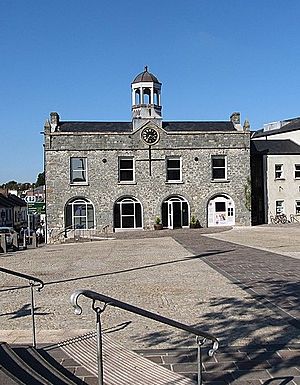Ballynahinch Market House facts for kids
Quick facts for kids Ballynahinch Market House |
|
|---|---|

Ballynahinch Market House
|
|
| Location | Market Square, Ballynahinch |
| Built | 1795 |
| Architectural style(s) | Neoclassical style |
|
Listed Building – Grade B1
|
|
| Official name: Old Court House, AKA Former market house, The Square, Ballynahinch, County Down | |
| Designated | 11 February 1980 |
| Reference no. | HB 18/07/005 |
| Lua error in Module:Location_map at line 420: attempt to index field 'wikibase' (a nil value). | |
The Ballynahinch Market House is a historic building in Ballynahinch, Northern Ireland. It's also been known as the Ballynahinch Court House and Ballynahinch Town Hall over the years. Today, it's a busy place where community events happen. It's also a special 'listed building', which means it's protected because of its history and importance.
Contents
A Look at Ballynahinch Market House History
The Ballynahinch Market House has a long and interesting past, dating back to the late 1700s. It was built to serve the local community in many ways.
Building the Market House
The idea for the building came from the Earl of Moira, a powerful local leader. He wanted a covered market where people could buy and sell goods. This would help the town's economy.
The first stone was laid on July 2, 1792. The building was finished in 1795. It was designed in the Neoclassical style, which means it looked like old Greek and Roman buildings. It had strong columns and a grand, balanced look.
The ground floor was open with arches, perfect for market stalls. Upstairs, there was a large room for meetings or events.
A Place of Conflict and Change
In June 1798, a big event happened right outside the Market House. A group called the Society of United Irishmen, led by Henry Munro, faced a lot of gunfire in what became known as the Battle of Ballynahinch. Munro was later taken to Lisburn and faced serious consequences.
In 1802, a man named David Ker bought the building and much of the town. He came to Ballynahinch because of its special medicinal springs.
Updates and New Uses
By the 1830s, the Market House needed some repairs. It was fixed up in 1841. During this time, a fancy dome-like structure called a cupola was added to the roof. A clock was also put in the front of the building.
For many years in the 1800s, the upstairs room was used as a court for small legal cases. It was also a classroom where people could learn about science and technology.
Modern Times and Community Focus
In May 1935, the Ker family sold the building to William James McCoubrey, a local businessman. He changed the ground floor into shops. The upstairs became a club for working men. In 1957, he changed the cupola on the roof to a small pyramid shape. He also added glass to the open arches on the ground floor.
In January 2001, a local group called the Ballynahinch Regeneration Committee bought the building. They started a big project to restore it. They removed the modern covering from the front. They also brought back the original arched openings and rebuilt the cupola to look like it did before. This work was finished in 2002.
In August 2010, the Down District Council took over the building. Now, the Ballynahinch Market House is a lively place for community events, bringing people together in Ballynahinch.

